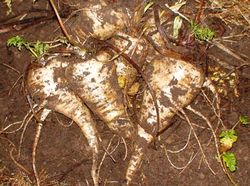Parsnip
Parsnip is also called white carrot. They resemble carrots but are paler in color and have a slightly spicy and sweet anise taste. Like carrots they are native to Eurasia and have been eaten since ancient times.
The vegetable is hardy so it's a good fresh vegetable that you can harvest throughout winter. Cover the soil around the plants with some straw when frost gets really heavy. You can harvest until in late spring the plants begin to flower. Low soil temperatures are necessary to develop the flavor of parsnip roots.
The seeds take long to germinate. Don't add compost or manure but make sure the soil is loose. Clayey and rocky soils are unsuitable as they produce short and forked roots. Sow in March and April directly in the soil.
Parsnips can be eaten raw, cooked or roasted. They are often used in stews and soups. They can also be fried or thinly sliced and made into crisps. The parsnip is richer in vitamins and minerals than the carrot. It is particularly rich in potassium and is also a good source of dietary fiber.
Be cautious in handling the leaves as they contain furanocoumarin, a photosensitive chemical that causes chemical burns to the skin. Symptoms are redness of the skin, burning and blisters. When bare skin comes in contact to the upper part of the parsnip plant, wash that area and keep out of sunlight.
See also
External links
- Parsnip "The parsnip (Pastinaca sativa) is a root vegetable related to the carrot. Parsnips resemble carrots, but are paler than most carrots and have a sweeter taste, especially when cooked." - Wikipedia
Comments
- You need to be logged into your Facebook account to post comments


